2011 NISSAN MURANO seat adjustment
[x] Cancel search: seat adjustmentPage 27 of 433
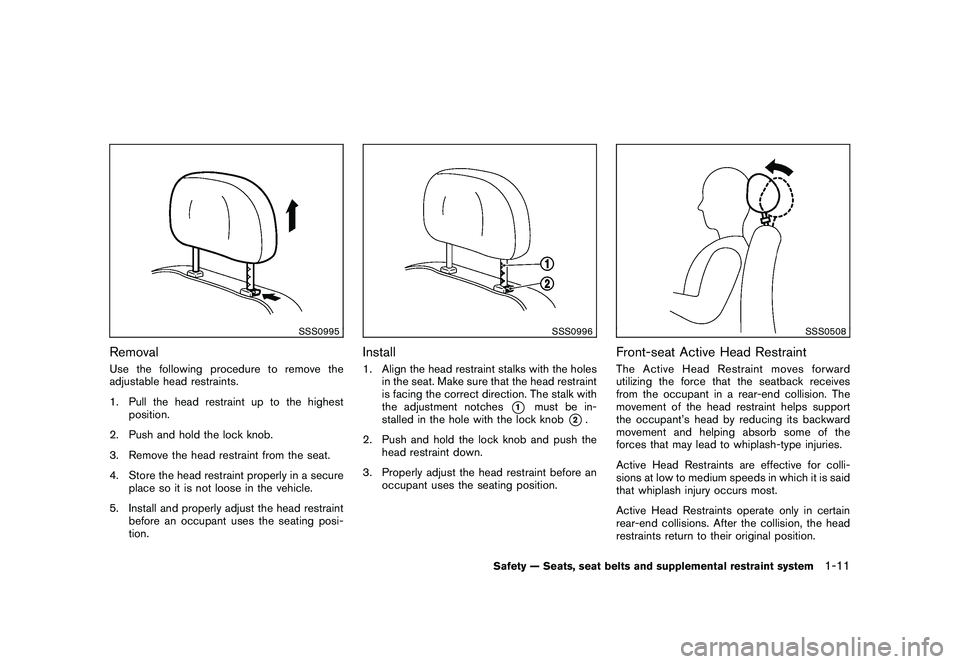
Black plate (25,1)
Model "Z51-D" EDITED: 2010/ 7/ 23
SSS0995
RemovalUse the following procedure to remove the
adjustable head restraints.
1. Pull the head restraint up to the highestposition.
2. Push and hold the lock knob.
3. Remove the head restraint from the seat.
4. Store the head restraint properly in a secure place so it is not loose in the vehicle.
5. Install and properly adjust the head restraint before an occupant uses the seating posi-
tion.
SSS0996
Install1. Align the head restraint stalks with the holesin the seat. Make sure that the head restraint
is facing the correct direction. The stalk with
the adjustment notches
*1
must be in-
stalled in the hole with the lock knob
*2.
2. Push and hold the lock knob and push the head restraint down.
3. Properly adjust the head restraint before an occupant uses the seating position.
SSS0508
Front-seat Active Head RestraintThe Active Head Restraint moves forward
utilizing the force that the seatback receives
from the occupant in a rear-end collision. The
movement of the head restraint helps support
the occupant’s head by reducing its backward
movement and helping absorb some of the
forces that may lead to whiplash-type injuries.
Active Head Restraints are effective for colli-
sions at low to medium speeds in which it is said
that whiplash injury occurs most.
Active Head Restraints operate only in certain
rear-end collisions. After the collision, the head
restraints return to their original position.
Safety — Seats, seat belts and supplemental restraint system
1-11
Page 28 of 433
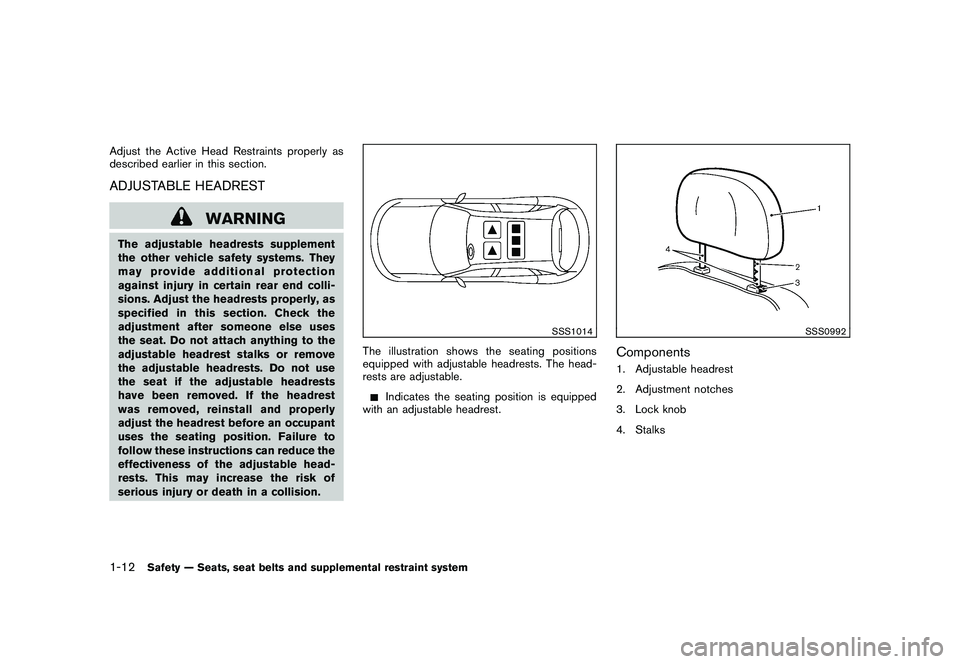
Black plate (26,1)
Model "Z51-D" EDITED: 2010/ 7/ 23
Adjust the Active Head Restraints properly as
described earlier in this section.ADJUSTABLE HEADREST
WARNING
The adjustable headrests supplement
the other vehicle safety systems. They
may provide additional protection
against injury in certain rear end colli-
sions. Adjust the headrests properly, as
specifiedinthissection.Checkthe
adjustment after someone else uses
the seat. Do not attach anything to the
adjustable headrest stalks or remove
the adjustable headrests. Do not use
the seat if the adjustable headrests
have been removed. If the headrest
was removed, reinstall and properly
adjust the headrest before an occupant
uses the seating position. Failure to
follow these instructions can reduce the
effectiveness of the adjustable head-
rests. This may increase the risk of
serious injury or death in a collision.
SSS1014
The illustration shows the seating positions
equipped with adjustable headrests. The head-
rests are adjustable.
Indicates the seating position is equipped
with an adjustable headrest.
SSS0992
Components1. Adjustable headrest
2. Adjustment notches
3. Lock knob
4. Stalks
1-12
Safety — Seats, seat belts and supplemental restraint system
Page 29 of 433
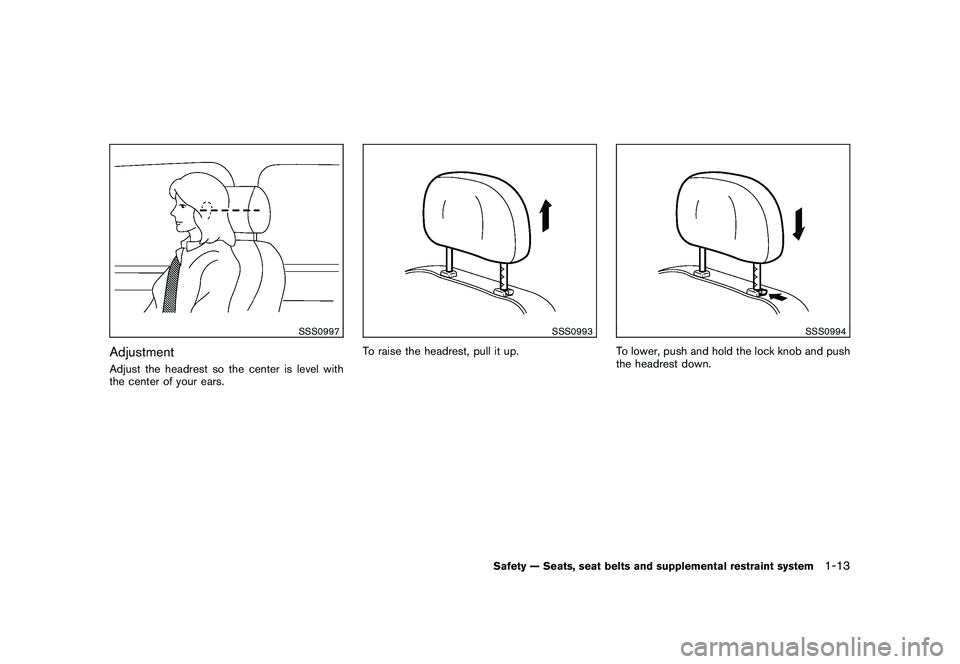
Black plate (27,1)
Model "Z51-D" EDITED: 2010/ 7/ 23
SSS0997
AdjustmentAdjust the headrest so the center is level with
the center of your ears.
SSS0993
To raise the headrest, pull it up.
SSS0994
To lower, push and hold the lock knob and push
the headrest down.
Safety — Seats, seat belts and supplemental restraint system
1-13
Page 30 of 433
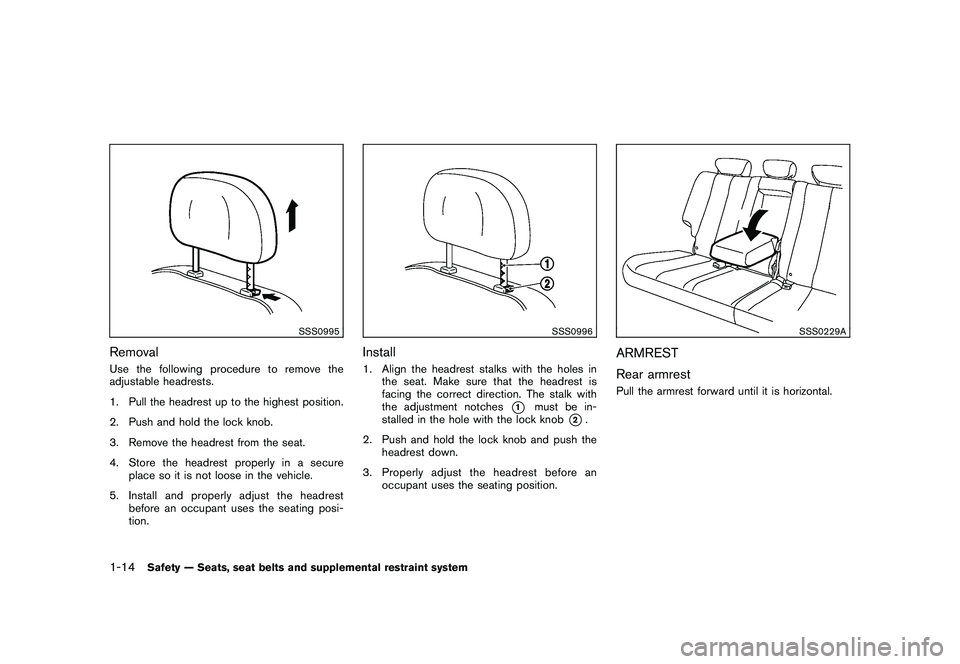
Black plate (28,1)
Model "Z51-D" EDITED: 2010/ 7/ 23
SSS0995
RemovalUse the following procedure to remove the
adjustable headrests.
1. Pull the headrest up to the highest position.
2. Push and hold the lock knob.
3. Remove the headrest from the seat.
4. Store the headrest properly in a secureplace so it is not loose in the vehicle.
5. Install and properly adjust the headrest before an occupant uses the seating posi-
tion.
SSS0996
Install1. Align the headrest stalks with the holes inthe seat. Make sure that the headrest is
facing the correct direction. The stalk with
the adjustment notches
*1
must be in-
stalled in the hole with the lock knob
*2.
2. Push and hold the lock knob and push the headrest down.
3. Properly adjust the headrest before an occupant uses the seating position.
SSS0229A
ARMREST
Rear armrestPull the armrest forward until it is horizontal.
1-14
Safety — Seats, seat belts and supplemental restraint system
Page 36 of 433
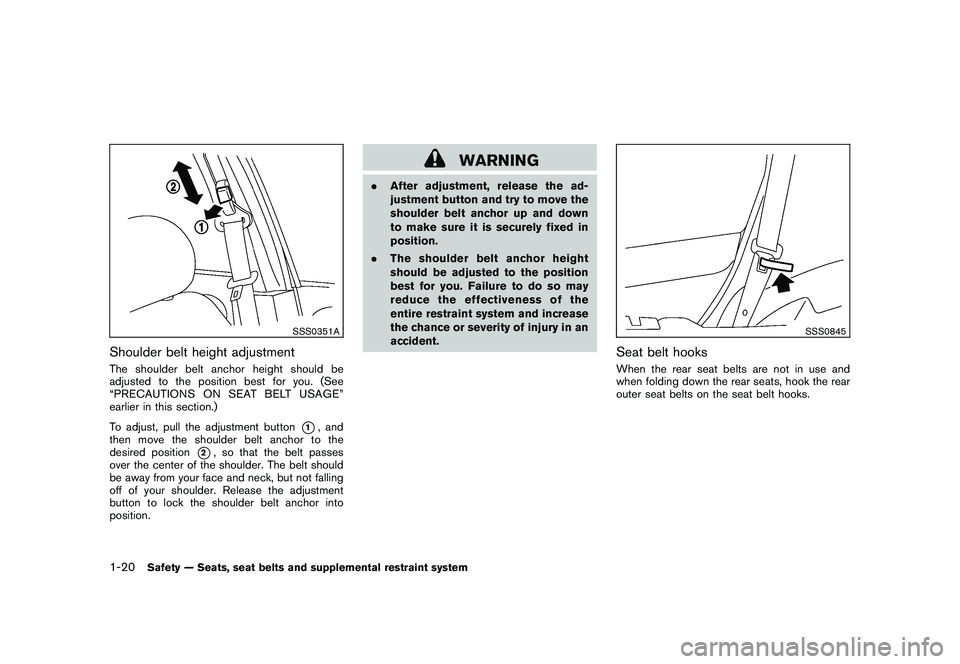
Black plate (34,1)
Model "Z51-D" EDITED: 2010/ 7/ 23
SSS0351A
Shoulder belt height adjustmentThe shoulder belt anchor height should be
adjusted to the position best for you. (See
“PRECAUTIONS ON SEAT BELT USAGE”
earlier in this section.)
To adjust, pull the adjustment button
*1, and
then move the shoulder belt anchor to the
desired position
*2, so that the belt passes
over the center of the shoulder. The belt should
be away from your face and neck, but not falling
off of your shoulder. Release the adjustment
button to lock the shoulder belt anchor into
position.
WARNING
. After adjustment, release the ad-
justment button and try to move the
shoulder belt anchor up and down
to make sure it is securely fixed in
position.
. The shoulder belt anchor height
should be adjusted to the position
best for you. Failure to do so may
reduce the effectiveness of the
entire restraint system and increase
the chance or severity of injury in an
accident.
SSS0845
Seat belt hooksWhen the rear seat belts are not in use and
when folding down the rear seats, hook the rear
outer seat belts on the seat belt hooks.
1-20
Safety — Seats, seat belts and supplemental restraint system
Page 43 of 433

Black plate (41,1)
Model "Z51-D" EDITED: 2010/ 7/ 23
install a forward-facing child
restraint in the front seat, see
“FORWARD-FACING CHILD RE-
STRAINT INSTALLATION USING
THE SEAT BELTS” later in this
section.
— Even with the NISSAN Advanced Air Bag System, never install a
rear-facing child restraint in the
front seat. An inflating air bag
could seriously injure or kill a
child. A rear-facing child re-
straint must only be used in the
rear seat.
—Besuretopurchaseachild restraint that will fit the child
and vehicle. Some child re-
straints may not fit properly in
your vehicle.
— Child restraint anchor points are designed to withstand loads
from child restraints that are
properly fitted.
— Never use the anchor points for adult seat belts or harnesses.
— A child restraint with a top tether strap should not be used in the
front passenger seat.
— Keep seatbacks as upright as possible after fitting the child
restraint.
— Infants and children should al- ways be placed in an appropri-
ate child restraint while in the
vehicle.
. When the child restraint is not in
use, keep it secured with the LATCH
system or a seat belt. In a sudden
stop or collision, loose objects can
injure occupants or damage the
vehicle.
CAUTION
A child restraint in a closed vehicle can
become very hot. Check the seating
surface and buckles before placing a
child in the child restraint.
This vehicle is equipped with a universal child
restraint anchor system, referred to as the
LATCH (Lower Anchors and Tethers for CHil-
dren) system. Some child restraints include rigid
or webbing-mounted attachments that can be
connected to these anchors.
For details, see “Lower Anchors and Tethers for
CHildren (LATCH) System” later in this section. If you do not have a LATCH compatible child
restraint, the vehicle seat belts can be used.
Several manufacturers offer child restraints for
infants and small children of various sizes. When
selecting any child restraint, keep the following
points in mind:
.
Choose only a restraint with a label certifying
that it complies with Federal Motor Vehicle
Safety Standard 213 or Canadian Motor
Vehicle Safety Standard 213.
. Check the child restraint in your vehicle to
be sure it is compatible with the vehicle’s
seat and seat belt system.
. If the child restraint is compatible with your
vehicle, place your child in the child restraint
and check the various adjustments to be
sure the child restraint is compatible with
your child. Choose a child restraint that is
designed for your child’s height and weight.
Always follow all recommended procedures.
All U.S. states and Canadian provinces or
territories require that infants and small
children be restrained in an approved child
restraint at all times while the vehicle is
being operated. Canadian law requires the
top tether strap on forward-facing child
restraints to be secured to the designated
anchor point on the vehicle.
Safety — Seats, seat belts and supplemental restraint system
1-27
Page 51 of 433
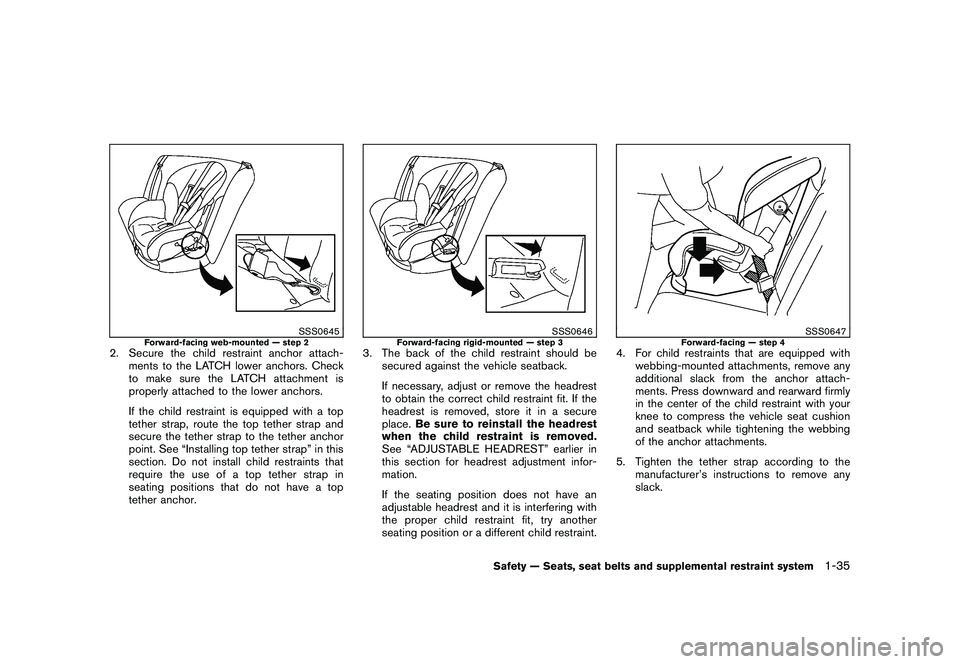
Black plate (49,1)
Model "Z51-D" EDITED: 2010/ 7/ 23
SSS0645
Forward-facing web-mounted — step 2
2. Secure the child restraint anchor attach-ments to the LATCH lower anchors. Check
to make sure the LATCH attachment is
properly attached to the lower anchors.
If the child restraint is equipped with a top
tether strap, route the top tether strap and
secure the tether strap to the tether anchor
point. See “Installing top tether strap” in this
section. Do not install child restraints that
require the use of a top tether strap in
seating positions that do not have a top
tether anchor.
SSS0646
Forward-facing rigid-mounted — step 3
3. The back of the child restraint should besecured against the vehicle seatback.
If necessary, adjust or remove the headrest
to obtain the correct child restraint fit. If the
headrest is removed, store it in a secure
place. Be sure to reinstall the headrest
when the child restraint is removed.
See “ADJUSTABLE HEADREST” earlier in
this section for headrest adjustment infor-
mation.
If the seating position does not have an
adjustable headrest and it is interfering with
the proper child restraint fit, try another
seating position or a different child restraint.
SSS0647
Forward-facing — step 4
4. For child restraints that are equipped with webbing-mounted attachments, remove any
additional slack from the anchor attach-
ments. Press downward and rearward firmly
in the center of the child restraint with your
knee to compress the vehicle seat cushion
and seatback while tightening the webbing
of the anchor attachments.
5. Tighten the tether strap according to the manufacturer’s instructions to remove any
slack.
Safety — Seats, seat belts and supplemental restraint system
1-35
Page 53 of 433
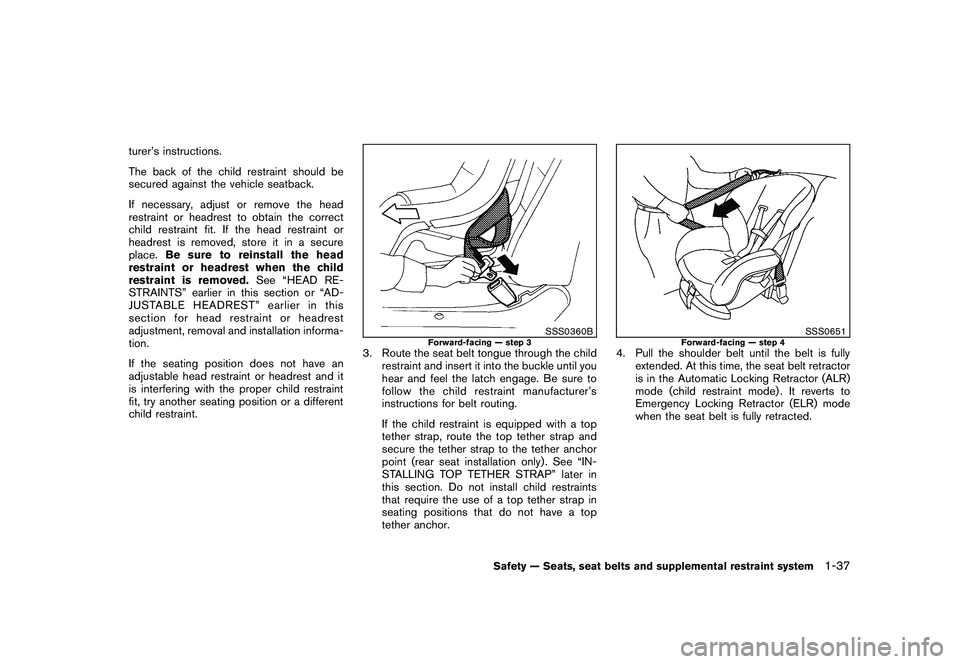
Black plate (51,1)
Model "Z51-D" EDITED: 2010/ 7/ 23
turer’s instructions.
The back of the child restraint should be
secured against the vehicle seatback.
If necessary, adjust or remove the head
restraint or headrest to obtain the correct
child restraint fit. If the head restraint or
headrest is removed, store it in a secure
place.Be sure to reinstall the head
restraint or headrest when the child
restraint is removed. See “HEAD RE-
STRAINTS” earlier in this section or “AD-
JUSTABLE HEADREST” earlier in this
section for head restraint or headrest
adjustment, removal and installation informa-
tion.
If the seating position does not have an
adjustable head restraint or headrest and it
is interfering with the proper child restraint
fit, try another seating position or a different
child restraint.
SSS0360B
Forward-facing — step 3
3. Route the seat belt tongue through the child restraint and insert it into the buckle until you
hear and feel the latch engage. Be sure to
follow the child restraint manufacturer’s
instructions for belt routing.
If the child restraint is equipped with a top
tether strap, route the top tether strap and
secure the tether strap to the tether anchor
point (rear seat installation only) . See “IN-
STALLING TOP TETHER STRAP” later in
this section. Do not install child restraints
that require the use of a top tether strap in
seating positions that do not have a top
tether anchor.
SSS0651
Forward-facing — step 4
4. Pull the shoulder belt until the belt is fullyextended. At this time, the seat belt retractor
is in the Automatic Locking Retractor (ALR)
mode (child restraint mode) . It reverts to
Emergency Locking Retractor (ELR) mode
when the seat belt is fully retracted.
Safety — Seats, seat belts and supplemental restraint system
1-37